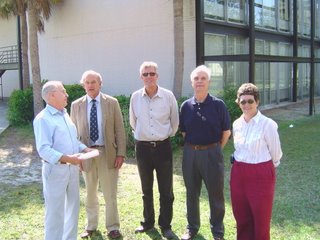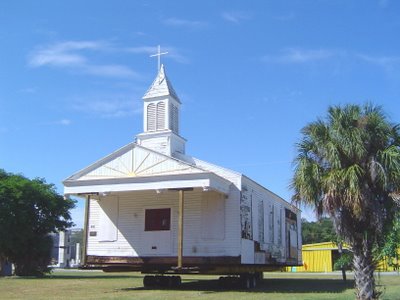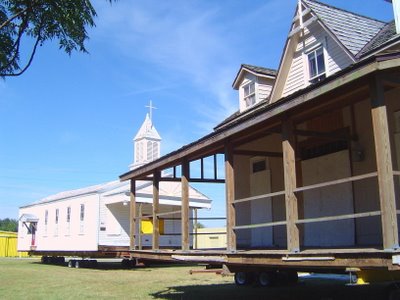Tuesday, October 31, 2006
DeMarcay Comes to City Commission
Several issues have been debated concerning this proposal.
The developers will save the facade (or a replica) of the DeMarcay Hotel on Palm and the Cigar Factory building on MiraMar Ct. The developers also propose an 18 story building on the narrow site and have asked for the downtown residential overlay density bonus - an increase from 50 u/a to 200 u/a in exchange for 3% of the selling price of the extra units.
The height will shade and allow views of the pool area of the 1350 Main building just north of the proposed building.
Palm Ave. business disruption has been horrendous during the 1350 Main construction process (it still continues). This has resulted in severe strain on the Palm merchants for two+ years as their customers have not ventured onto Palm. Some merchants have closed or moved.
Parking at the proposed DeMarcay has also been an issue. An elevator will be used and concern about "staging" cars to be parked is questioned. Will these cars cause congestion on Palm, i.e., when a Van Wezel performance ends and many residents return to their condo at the same time?
SOS would propose that if the DROD is given and the height is allowed, the developer be required to absolutely not interfere with easy travel and parking on Palm. There should be no additional consequence for the Palm merchants. There should be no interference on MiraMar Ct with the Methodist church and day care access and safety. Additionally the developer should be required to ensure that there will be no traffic blockage due to car staging on public streets; room in the building must be available (even if it requires a loss of some business or residential space) or an off site staging area must be secured.
Construction and parking in larger cities are accomplished with no disruption to surrounding businesses and traffic. The developer has said they have experienced construction companies in place that can accomplish this. Requiring this should not be an issue.
If the developer cannot meet these requirements then the proposal should not be allowed as submitted.
Concerning views and shade, the developers of the adjacent buildings can argue this issue capably. It will be interesting to see the arguments that are used and which are listened to by the commissioners.
Monday, October 30, 2006
More on School Avenue
The workshop was facilitated by Jerry Sparkman, architect at Totems Inc. The meeting tonight was described as the first step in a three phase process: community outreach, design charette and implementation.
Introductory remarks focused on recent examples of density with good design as noted in the principles of new urbanism. Five examples (several by noted designer Stefanos Polyzoides) were described that showed densities ranging from 35 to 80 units per acre that consisted of buildings of 2 to 4 stories in height. One example showed a 100 u/a project with 7 to 8 story heights. The Spanish Oaks apartments in Laurel Park was also shown as an example of 50 u/a. Here are some pictures, like the ones shown, that indicate what various densities can look like.
Nearly all the participants indicated that these projects showed good design and could work here: they were not shear, block buildings, but consisted of a variety of building types that looked more like single family housing. The low height was also a significant factor.
Concern was expressed about the traffic that would result from this proposal. Even though the traffic study showed no level of service degradation, the "cut through" streets in Alta Vista were not included in the study. This is the concern expressed by the neighbors.
Connectivity of the surrounding neighborhood to Payne Park was discussed. Pedestrian access through the proposed project would help this. It was pointed out that a major element of new urbanism is connectivity.
Burks indicated that his goal was to get as many ideas as possible on the table, he would include as many ideas as was possible.
Near the end of the evening, when the ideas were being summarized, Burks indicated that height and density had already been approved by the commissioners and were not part of the discussion. These are required to get affordable housing.
A discussion of the affordable housing indicated that building 4 would contain all affordable housing and would have the same floor plan as the other two large buildings.
Comments were made that today’s view of affordable housing projects includes mixing them with all of the market units; the days of stand alone "Cabrini Green" type projects were no longer acceptable. Even the redevelopment of Sarasota’s public housing will mix market rate rentals and home owner units with low income public housing and subsidized units.
It would seem that the size of the affordable units in the School Avenue proposal could be adjusted so that these units could be mixed with higher priced units and achieve lower overall project heights. The reason that the developments pictured at the beginning of the evening were 2 to 4 stories is because the units were smaller in square footage.
Stefanos Polyzoides has indicated that:
Affordable housing and workplaces should have the following characteristics:
1. Building type should be indistinguishable from market rate housing or workplaces.
2. They should be provided in a variety of building types.
3. They should be provided in smaller increments.
4. They should be mixed with market rate housing and workplaces.
These are the ideas that were articulated tonight, they need to be creatively addressed if common ground is to be found for this proposal.
The ball is back in Ron Burks' hand. He has indicated he would open the process up, ask for input and evaluate the ideas. If he insists on keeping the same height and density with the same block face design not much will have been accomplished. However, the opportunity is available to use some new thinking to creatively find a solution to the issue. Can community input and developer good faith result in a well designed project that the entire community can support? We will find out.
We hope the process continues and that many of the ideas presented can be worked into the project and the result is a project about which everyone can say "This turned out to be a wonderful project for our city."
Sunday, October 29, 2006
Negative Ads and Integrity
We have become inured to all the negative ads during the current campaign. It seems that both candidates for many positions are slinging mis-truths and half-truths around like crazy.
Another ad has appeared that is a little different.
Laura Benson has recently started running negative ads in the race for District 69 State House. Her opponent, Keith Fitzgerald, stated in a Tiger Bay forum that the ads are lies. He has pointed out that his 1996 book, apparently referred to in the ads, is a policy study that clearly says that uncontrolled immigration must be controlled or our country will face many serious difficulties. He has also pointed out that immigration policy is a federal government policy issue according to the U S Constitution, not a state policy issue.
What is disturbing is that while both Fitzgerald and Benson signed pledges with the Civic League that they would not engage in negative ads, Fitzgerald has kept his pledge, but Benson has not.
SOS does not endorse candidates. However one of our mission principles is that we "preserve, enhance and promote integrity of public management". We have difficulty with a candidate that pledges not to use negative ads then goes ahead and runs negative ads anyway.
Can an elected official maintain integrity during the term of office when they obviously show a lack of integrity while running for office?
Saturday, October 28, 2006
Charles Gwathmey Visits Rudolph's Riverview Building
 Members of the Save Riverview group met with Charles Gwathmey on Oct 26 at Riverview High School.
Members of the Save Riverview group met with Charles Gwathmey on Oct 26 at Riverview High School.Shown are Carl Abbott (architect), Charles Gwathmey, Guy Peterson (architect), Richard Storm (architecture critic) and Lee Byron (former Sarasota School Board member).
Gwathmey was visiting Sarasota to participate in an awards ceremony honoring Abbott, Peterson and other architects. One of his current projects is restoration of Paul Rudolph's School of Art and Architecture Building at Yale University.
Gwathmey had previously written to the Sarasota School Board urging them to reconsider the decision to demolish Rudolph's Riverview High building.
Gwathmey said in his letter : "Riverview High School is a historic building and modernism is now a critical and legitimate period in the continuum. The architectural legacy of the "Sarasota School" is a laboratory for students and architects, and Riverview is a pertinent, iconic representative work.
The building also pioneered "green architecture" initiatives, that were both intuitive and visionary, that could be restored, refined and reinforced as examples of environmental awareness and sensitivity."
We continue to urge the school board to review their decision. In addition to the world wide architecture community urging rehabilitation for historic reasons, it is becoming more and more apparent that the cost of saving the building (the steel, glass and concrete) will be a significant savings compared to current estimates for a new building.
Thursday, October 26, 2006
Free Plants at Garden Club
 The Sarasota Garden Club is having their annual PlantShare event this Saturday - Oct 28, from 9 to 12.
The Sarasota Garden Club is having their annual PlantShare event this Saturday - Oct 28, from 9 to 12.The Garden Club members will be giving free plants to anyone that visits the event. There is no charge for this and you can get free advice how to plant and care for you new plants! This is a deal you cannot pass up.
You can also wander around their beautiful grounds while you are there. Why not take this opportunity learn a bit about the Sarasota Garden Club and add some greenery to your yard?
The Garden Club is located at the corner of 41 and Blvd of the Arts in Sarasota.
Wednesday, October 25, 2006
Bozos in Sight
We hope people will find them interesting and that Tidewell will raise funds to help continue their great service.










Burks' Meeting To Discuss School Ave Proposal
Ronald H. BurksYou are invited to participate, along with other thoughtful members of our Sarasota community, in an open to the public discussion and idea sharing process concerning the residential/retail development proposed along School Avenue, across from Payne Park.
The development of this 9.52-acre property will be highly visible for many years by all those who visit Payne Park or drive down School Avenue, so it is important that its development be a contribution and enhancement to downtown and to the community and that the community be proud of the quality of the development.
The discussion will take place on Monday evening, October 30th at 7:00 p.m. at the Sarasota Herald Tribune building at 1741 Main Street in the meeting room off the main lobby. Jerry Sparkman (Totems Architecture), President of the Gulf Coast chapter of the American Institute of Architects of Sarasota, will facilitate the discussion and encourage active participation and dialogue from neighbors and concerned citizens starting with discussion about the proposed, proffered Master Site Plan and Building Sections.
This meeting is intended to encourage a more meaningful, productive community dialogue in the redevelopment of this important property using planning concepts of “New Urbanism” to create a functional mixed-use development. Hopefully this meeting will further serve as an opportunity to move toward a consensus as to the most desirable manner in which this property can be developed.
With everyone’s participation, this meeting can serve as an invaluable learning experience for us all and I hope that you will be able to attend on Monday evening, October 30th.
Quincy Investments, LLC
2151 Main Street
Sarasota, Florida 34237
Phone: 941/366-7000
Fax: 941/366-7097
Cell: 941/223-7800
Email: rburks@quincyinvestments.com
I asked Ryan Chapdelain (City Neighborhood Partnership Office) about this. His response was:
Attached you will see the notice for a voluntary neighborhood meeting that Mr. Burks requested the City send out to all affected parties within a 500-foot radius of the subject property (including adjacent neighborhood associations and CCNA). As you can see, this is not an official City neighborhood workshop, nor was it required by the City. The Clerk's office received this request late Monday and notices should be sent out by tomorrow (if they haven't already). Any questions as to the details of the meeting should be directed to the contact information at the top of Mr Burks's notification memo, as this is the only information the City has received regarding this meeting. However, I was told minutes will be taken, arranged by Mr. Burks.
Tuesday, October 24, 2006
A Good Read
 This is an excellent book. Anyone with an interest in Florida history, development, environment and politics should read this book. It is available at the library and book stores. The author, Michael Grunwald, will be featured at the upcoming Sarasota Reading Festival.
This is an excellent book. Anyone with an interest in Florida history, development, environment and politics should read this book. It is available at the library and book stores. The author, Michael Grunwald, will be featured at the upcoming Sarasota Reading Festival.Some reviews:
The New York Times: "Mr. Grunwald, a terrific writer, moves along at a cracking pace. The Swamp abounds in rascals, visionaries and visionary rascals. One of Mr. Grunwald's virtues is his clear-eyed refusal to impose present-day standards on past behavior. The dredges dig, the railroad advances, the politicians scheme and the dreamers paint their Technicolor fantasies. The Everglades, Mr. Grunwald writes, was always too subtle to command love and respect, "less ooh or aah than hmm." In his hands, the ooh and aah come to life." --March 8, 2006
The Washington Post: "In recent years, writers have devoted a lot of ink to the tortured history of south Florida's Everglades. But no one has nailed that story as effectively, as hauntingly and as dramatically as Michael Grunwald does in The Swamp , a brilliant work of research and reportage about the evolution of a reviled bog into America's -- if not the world's -- most valuable wetland." --March 30, 2006
New York Times Sunday Book Review: "Michael Grunwald, a talented Washington Post reporter, understands that South Florida is South Florida because so much miscreancy has gone into the making of it. His first book, "The Swamp," a biting, exhaustively reported work of environmental history, tracks the story of the central "obstacle" in the development and settlement of the peninsula, namely, its water. The Everglades were hostile to settlement. For that effrontery, the United States decided to wring this wilderness dry.
Grunwald's point is that this battle has never really stopped. "The Swamp" is a sort of tapestry, or a really long W.P.A. mural, with a cast of characters whose extreme labors yield a grand, violent, picaresque history of the southern tier of this state. This book serves up 500 years of bloody, mostly foolish, rarely noble, but always entertaining human antics executed by legions of capable (but really nutty) conquistadors, generals, engineers, mobsters, politicians and rich-boy developers as they hacked at each other and the swamp." --April 8, 2006
Palm Beach Post: "Magnificent. Michael Grunwald, a reporter for The Washington Post , accomplished in two years what the rest of us scribblers have been dithering over for a decade or more. His definitive history reads as quickly as a good magazine article. Best of all, The Swamp is up-to-the-minute...Among the book's strengths are Grunwald's pen-portraits of the characters whose careers intertwined with the Everglades, a kind of Madame Tussaud's waxworks of rogues and saints."--July 30, 2006
Reader Request
I am an avid reader of your blog and find the postings on the blog to be extremely informative. I am writing you to see if you could mention our issue on your website and possibly link to our website with information on our problem. Sarasota County is trying to make an access road from the Knights Trail Landfill to Clark Road. This proposed road would enter Clark Road near the entrance to Saddle Creek.
Sarasota County informed only select communities east of I-75, which means that not everyone was notified regarding the proposed road. As far as we can tell owners in Myakka Valley Ranches and Gator Creek were not notified about the public meetings being held by the county.
This change would affect all communities in the Clark Road Corridor between I-75 and Myakka State Park as well residents along Bee Ridge Extension. This includes: Myakka Valley Ranches, The Forest at Hi Hat, Saddle Oak Estates, Saddle Creek, Gator Creek, Misty Creek, Timberland, East Lake, The Preserve at Heron Lake, Serenoa and many others.
While opening this proposed road to regular traffic would certainly be of benefit to land developers in South Sarasota County, it would be bad for Clark Road residents. Below are just a few of the reasons people should attend the public meeting on Monday October 30, 2006 at Twin Lakes Park and tell the county NO:
- Dangerous. 200 to 400+ garbage trucks weighing in excess of 40,000 pounds would be traveling on this precarious two lane road which will certainly result in increased accidents and fatalities.
- Bad for the surrounding environment. These garbage trucks will be traveling through land that is identified as environmentally sensitive.
- Decreased property values. Traffic jams and hundreds of 40,000 pound garbage trucks will certainly decrease the desirability and property value of all neighborhoods along Clark Road.
- Longer Commute Times. An additional traffic light on Clark Road for the proposed access will add to longer commutes for Clark Road communities.
- Far too costly. Sarasota County projects usually cost far more than early estimates (e.g.: Riverview High School Renovation).
- More developments. The proposed road will open the door for more developments. Bad for Clark Road neighborhoods, good for South County Land Developer's.
THERE IS NOTHING IN THIS PROPOSED PLAN THAT WOULD BE GOOD FOR CLARK ROAD COMMUNITIES!
We would appreciate any link or information you could post on your blog regarding this proposed road.
Thank you,
Clark Road Resident
Monday, October 23, 2006
Environmental Forum - All Invited
 Sarasota County's Department of Health has been sponsoring a series of Environmental Health Forums. One will be held this week on Wednesday Oct 25 at the Waldemere Fire Satation.
Sarasota County's Department of Health has been sponsoring a series of Environmental Health Forums. One will be held this week on Wednesday Oct 25 at the Waldemere Fire Satation.These forums are designed to seek citizen input on environmental issues that are affecting health of residents and visitors. This is an opportunity for everyone to give their input early in the process. The process is titled "PACE EH", an acronym for "Protocal for Assessing Community Excellence in Environmental Health."
The process is designed to improve decision making by taking a collaborative community-based approach to solving environmental health concerns of the community.
The PACE EH Sarasota Coastal Communities team consists of a diverse mixture of government employees, citizens, non-profit organizations, environmental groups and educational institutions.
The community identifies environmental health issues to be addressed by the PACE EH team.
The goal of the process is to allow the voice of the community to be heard and response to be given in the form of action plans. Together, we can protect and preserve the environmental health of our coastal communities.
For more information, check their website.
Sunday, October 22, 2006
New Trend?
In my neighborhood a "mega garage" is under construction. Apparently it contains a guest house above the garage. It is separate from the main home, which also has a garage.

Thursday, October 19, 2006
A Milestone - Again
This blog started in March of 2005 and in 9 months 10,000 page views had been recorded. In the next 10 months, 20,000 more page views have been recorded.
We are pleased that many visitors find interesting commentary here.
A Bayside To Be?
 Here is a fanciful rendering of the proposed Sarasota Bayside development. Some information can be found at the architect's web-site HKR Architects.
Here is a fanciful rendering of the proposed Sarasota Bayside development. Some information can be found at the architect's web-site HKR Architects.
Wednesday, October 18, 2006
Hiaasen on Amendment 3
Special interests behind push for Amendment 3
BY CARL HIAASEN
One of the most audacious and cynical attacks on the rights of Florida voters will appear as ''Amendment 3'' on the Nov. 7 ballot.
A coalition of powerful special interest groups wants to amend the state Constitution to make it harder to -- of all things -- amend the state Constitution.
To thwart grass-roots movements that threaten their chokehold on the Tallahassee power structure, the promoters of Amendment 3 want the rules changed so that all future amendments will require 60 percent of the popular vote, instead of the current simple majority.
Those conspiring in this power grab are hiding behind a lofty-sounding front called ''Protect Our Constitution,'' which more truthfully ought to be named ``Protect Our Political Connections.''
Among the industry lobby groups and big-name companies that don't trust Floridians to shape their own constitution: The National Association of Home Builders, Blue Cross/Blue Shield, The Florida Association of Realtors, U.S. Sugar, The St. Joe Co., Lykes Bros. Inc., the Florida Chamber of Commerce and Publix (where shopping might be a pleasure, but civic activism is apparently an annoyance).
Most corporate donors to the Amendment 3 campaign aren't publicizing their involvement because they don't want Floridians to get the right idea -- that it's a sucker punch disguised as reform.
The entire point of citizens' initiatives is to enable frustrated voters to press an issue that their elected representatives have chosen to ignore. In Florida, the only way to do that is to change the Constitution.
A watershed example was the amendment banning the use of large commercial gill nets, which had been wiping out vast schools of game fish while indiscriminately killing other species, including turtles.
Top state lawmakers, several of whom were taking campaign contributions from the commercial fishing industry, refused for years to do anything about the nets.
Conservation groups then joined with recreational anglers and circulated hundreds of petitions to put the issue on a statewide ballot. The measure passed overwhelmingly in 1994.
Scrolling the list of Amendment 3's donors, you can understand why they're eager to shut the public out of the lawmaking business.
Ten years ago, Big Sugar spent millions to defeat a proposed amendment that would have levied a penny-per-pound tax on sugar, the revenue to be used for cleaning up the Everglades.
Publix and the Florida Chamber of Commerce were both stung by a 2004 amendment raising the minimum wage to $6.15 an hour -- something their toadies in the Legislature had loyally declined to do.
The construction and real-estate industries are desperately nervous about the growing push for a ''Hometown Democracy'' amendment that would give voters a direct voice in major growth decisions in their communities.
If Amendment 3 passes, Florida would be the only state in the nation requiring 60 percent voter approval for a citizen initiative. That means a minority of 41 percent could defeat any proposed change in the Constitution.
Supporters of that idea say that too many frivolous amendments are getting on the ballot these days. Their favorite target of scorn is the recent ban on cages for pregnant pigs, although it's not clear how that has inconvenienced anybody but a few hog farmers.
More irksome to well-connected special interests are the substantive amendments spawned by citizen groups -- the ban on indoor smoking, the limit on class sizes, the hike in the minimum wage, mandatory term limits for officeholders and the cap on tax hikes on homestead property.
In every instance, the reason that public activists got involved is because those elected to speak for the public wouldn't step to the plate. Not all those amendments were perfectly crafted, but neither are many of the laws passed by the Legislature.
Corporate players in Tallahassee know they can't seduce the majority of voters as easily as they seduce politicians. There's a certain scornful confidence, however, that 41 percent of the people can be persuaded to vote against just about anything, if enough money is spent on a slick media blitz.
That's how the folks behind Amendment 3 plan to sell the idea that it's an overdue refinement of the Constitution, when in truth it's a gift to big businesses and their lobbyists.
Voters do make mistakes -- look at some of the lightweights and losers who get elected to office. Eventually, though, the people get wise.
That's what happened to the 2000 amendment approving a high-speed bullet train. The concept looked nifty on paper, but in reality it was a recipe for a half-baked, budget-breaking boondoggle.
Thanks to vigorous campaigning by Gov. Jeb Bush, Floridians eventually saw the light, and the train amendment was repealed before the first inch of track was laid.
Opposition to Amendment 3 is bipartisan and diverse, from former Sen. Bob Graham to ultraconservative religious leaders. They're united in the view that any law that makes it more difficult for citizens to be heard -- and easier for special interests to stack the political deck -- is bad.
Amendment 3's supporters are hoping most people won't bother to read the fine print on the ballot item, and will instead fall for the well-financed hype.
The magic number to prove them wrong is 50.1 percent, at least for now. If you honestly want to protect Florida's Constitution, vote No on Amendment 3.
Tuesday, October 17, 2006
Diverse Opinions
Diversity of opinion is valuable in shaping Sarasota's future
[By] Ken Shelin, Sarasota city commissioner. (Appeared in the SHT on Oct 10.)
Men are inclined to cherish or value different things and therefore may choose differently, and yet all may choose correctly. A good society must be open, tolerant, flexible, and receptive to change."-- John Locke
This statement paraphrases an understanding of the fundamental nature of mankind described by John Locke in his "Essay Concerning Human Understanding." James Madison, our fourth president, understood that honest and sincere people can come to different conclusions about the same set of facts and still be correct.
Recently, I visited Montpelier, Madison's ancestral home in Virginia. While there, I purchased an extraordinary biography titled "James Madison," by Ralph Ketcham. Reading it has reminded me that no matter how political conditions and circumstances change, certain principles are timeless. Many of the political issues and principles of government debated at the foundation of our country are especially relevant to the discussions of development and land use in the city of Sarasota.
A fundamental constitutional principle arising from the Constitutional Convention debates was that human rights and property rights complement and buttress one another; neither trumps the other. Our public discussions on land-use matters here in Sarasota will only come to a just end if we ensure that every person, whether a resident, property owner, businessperson or developer, is treated fairly and receives an answer that assures his or her rights. It is simply unfair to do otherwise.
Certainly unanimity is not expected in any great political debate involving significant change and this has been documented repeatedly, especially in the city of Sarasota's efforts over the years to revive and redevelop its downtown. In such discussions, as Madison said, a spirit of amity and mutual concession are always necessary.
Each of us has an obligation to expose his or her opinions and assertions to a fair and reasoned discussion. But our public debates are too often polarized by demonization of those with whom we disagree. Honest disagreement does not mean that the opposing side is wrong, stupid or evil.As the city of Sarasota morphs into a more diverse, urbanized, cosmopolitan and dense city, especially downtown and in near-downtown neighborhoods, we need to recognize that time will bring change.
Sarasota has a downtown core that now attracts increased activity into a very compact area. This compactness is not only a challenge, but is an important asset because it is human scaled. Its scale has much to do with how quickly downtown has turned around from the empty and significantly unsafe era of the 1980s and early 1990s. It is certainly a work in progress because of public transportation and parking challenges, as well as the lack of significant retail. It is getting better and appears headed for even greater improvement.
We need affordable housing downtown. Many say that is unlikely with high land costs. Tools available to us and actions already taken have laid the foundation for future accomplishments in this area. In spite of multiple meetings and conferences, nobody has offered a more credible alternative than increased density to overcome high land costs. We need to manage increased density carefully, of course. Rejecting it, however, only increases the dislocation of our human resources in the city and encourages urban sprawl.
Let us celebrate the differences in our community instead of demonizing those with whom we disagree. Let us come together to gain the synergies for our community's future by cooperating with others whose ideas are different from our own.
As James Madison said, government that can overcome pettiness and give effect to the general and permanent good of the community finds safety in a multiplicity of forces.
-----------------------
Letter published Oct 12, 2006
What happened to Duany plan?
Regarding Sarasota City Commissioner Ken Shelin's guest column Tuesday on shaping Sarasota's future: change is inevitable. And there is good change and bad change. One strong principle for guiding us in the direction of good change is listening. Listening promotes discussion and community acceptance of change.
When decisions are made without community participation and understanding, the result is community dissatisfaction and anger. While this may lead to people saying some things that others characterize as "demonization," the root of the issue is lack of discussion, listening and compromise. This must start with the community leadership -- our city commissioners.
When our commissioners make decisions on major land-use changes before hearing from their constituents, and when they fail to elicit discussion about proposed changes, then the result will be anger and frustration.
We do not have an accepted vision that calls for Sarasota becoming an "urbanized, cosmopolitan, dense city", nor was this anyone's platform during the commission elections. Officials can expect angry, frustrated responses.
Sarasota developed a vision for downtown in 2000, the Duany plan. This vision was discussed and accepted by the community. While Sarasota is morphing, the vision has not been changed. Sarasota is morphing because of developer pressure and a lack of open, honest discussion with, and listening to, residents.
Bringing outlying areas into downtown, areas not included in the downtown plan nor allowed by the plan, is not a debate of human rights vs. property rights.
It is a change in the vision for our city made by a very small number of people against the will of the citizens and without citizen input -- as elicited in such an exemplary way by the lengthy, inclusive process used to develop the community vision for our downtown.
Richard Clapp
Monday, October 16, 2006
A Perspective

Through the library windows with their wrought iron design (sunrise or sunset?) and over the trees in Five Points Park you can see the top of the historic ten story "Orange Blossom Hotel", now condos above retail, and the yet to be completed "1350 Main" building, also condos above retail. The 1350 Main building has been topped out and its height is apparent.
Next up could be the proposed DeMarcay. This building will be situated behind the "1350 Main" building in this view. It will rise much higher than "1350 Main" and shadow it completely. The top of the DeMarcay would not be seen in this perspective
Sunday, October 15, 2006
Still On the Move
A site has been cleared at Pioneer Park and the buildings have been loaded onto beams that sit upon wheels, ready for a several block move. The buildings are in a vacant lot on the corner of 10th and Central.


May they find a final resting place.
Tuesday, October 10, 2006
Below are data on other downtown condos - listed is the percentage of units that take the homestead exemption:
5 Points Plaza - 28%
100 Central - 25%
Beau Ciel - 41%
Dolphin Tower - 51%
Encore - 27%
Library Mews - 64%
Marina Tower - 72%
Renaissance - 35%
Ritz-hotel - 33%
Ritz-condos - 35%
It is apparent that during the recent building boom a lot of speculation/investment was taking place. The newest buildings have the lowest owner/occupy rate. Many of these will likely show up on the market again. Few will contribute to year round people living in downtown Sartasota, people that would support businesses and give us the lively downtown the community envisioned.
Sunday, October 08, 2006
Coastal Connections
 A couple of recent stories by Bob Ardren in the Pelican have focussed on the changing waterfront in the Sarasota area. One concerns Cortez fishing village and the other is about Walt's Restaurant.
A couple of recent stories by Bob Ardren in the Pelican have focussed on the changing waterfront in the Sarasota area. One concerns Cortez fishing village and the other is about Walt's Restaurant.As one generation steps aside and the new takes over, a simpler way
 of life fades into the past. The stories from the era of a strong connection to the gulf waters - a connection that provided the livelihood for many families - are known by many that have spent a while in our coastal cities. Remnants of these stories still exist, mainly family stories and musuems.
of life fades into the past. The stories from the era of a strong connection to the gulf waters - a connection that provided the livelihood for many families - are known by many that have spent a while in our coastal cities. Remnants of these stories still exist, mainly family stories and musuems.These connections are a significant
 part of our place, our sense of place.
part of our place, our sense of place.I would encourage all of our readers to stop by Walt's for a lunch or dinner of excellent local fish (and read about the family history while there). In the 80's, when I visited Sarasota, the first stop was always Walt's on Washington. Oysters and a grouper sandwich washed down with some beer was the attraction. Now Walt's is on the South Trail but the food is just as great.
Also stop by Cortez and have a fresh fish lunch on their dock; watch the birds and the commercial fishing activity. Wander around the village and picture yourself living on this waterfront a few decades ago.

Both Walt's and Cortez have fish markets; you can take home some fresh caught fish or maybe some smoked mullet and savor it later.
These pictures are of Cortez - a fascinating place.
Maybe with a visit to one of these places you too will start connecting a little stronger to this sense of place.
Thursday, October 05, 2006
Downtown Condo Livin'
 A story in the latest Sarasota Magazine reports on occupied condos in downtown.
A story in the latest Sarasota Magazine reports on occupied condos in downtown.At the Plaza on Main, 15 out of 49 are lived in by owners that take the homestead exemption. Apparently the others are speculators or they are "vacation residences."
Up the street at 100 Central, property records reveal that only 25 of 97 owners take the homestead exemption.
"What we found at the Plaza may be indicative of what to expect as seven downtown projects with 769 condominiums near completion this year and another 1,400 condos are teetering on the drawing boards," says Kim Hackett of the Sarasota Magazine.
Not exactly a rousing start to the movement to downtown living. It will be interesting to see the stats for 1350 Main when that building becomes occupied.
Wednesday, October 04, 2006
City Meetings Available on Your Computer
City of Sarasota gets high-tech: The Sarasota City Commission has put video of all of its archived public meetings online. Meetings will be available online within 24 hours and you don’t have to watch a whole meeting to get to the part that interests you – you can simply scroll through the online agenda, click on the agenda item that interests you, and go right to that portion of the meeting. An extensive key word search is available, as well as closed captioning. Check it by going to www.sarasotagov.com and click on “Watch Live and Archived Meeting Video.”
This streaming video has been available for a couple months and it works well. Having the archived videos available is a tremendous resource.
We thank the city officials for making this available. We especially thank City Clerk Billy Robinson, and his department, for actively pursuing this and making it happen.
Tuesday, October 03, 2006
Charter Review and the Elected Mayor Question
The Charter review commission seems to think that an elected Mayor would be a good idea and that the office should have powers to fire the City Manager, propose the budget, set the agenda, veto a proposal, appoint the Planning Commission members, appoint Advisory Board members and generally rule the roost.
Of course, these powers are not endorsed unanimously - even by the most ardent supporters of the "elected mayor" concept.Indeed, they are not sure such a mayor should serve four years or if any commissioner should serve four years.
But the chair keeps reminding his fellows that such drastic changes "simply will not fly." That, taking the incremental step of endorsing an elected mayor without endowing the office with significantly greater powers may be the best way to gain support of the voters.
Notable throughout all these meetings and echoed again today (with Elsie Souza's admission that she did not know how the agenda was currently set) is the undeniable fact that the commission has not defined the problem beyond the amorphous need for "better leadership," greater "accountability" and similar phrases.
Absent a clearly defined statement of the problem(s), it is inconceivable that such a body can come to a rationale conclusion as to a solution (or two).
I suspect their anticipated recommendation to put the question to the voters will likely result in another defeat at the polls should the City Commission decide to place the question on the next ballot.
Surely the question will be raised by those debating the issue "What problem is this change intended to solve and how shall the change work to effect the solution?" Basically, the move to an elected mayor seems intent upon changing our "City Manager" form of government. We need someone to "work our vision," "staff has to know which direction to go in," are the sort of statements you will hear should you take the time to watch these folks. And, from the examples used ("Failure of the Downtown Density Bonus," or a "Charter level Director of Development to take the Planning Department under his wing"), one gets the distinct impression that this is a development- driven movement.
We have an increasing number of new arrivals who have significant real property investments, cash, lawyers and, apparently, a new vision for the City of Sarasota "A Dense New Urban City with Small-Town Amenities."
You can see the recent Charter Review discussion here , click on the Sept 26 Charter Review link.
Monday, October 02, 2006
Cultural District Decisions

Boston's new Institute of Contemporary Art building will be opening soon.
A recent press release says:
The Institute of Contemporary Art (ICA) will open its new waterfront museum this fall. Designed by celebrated architects Diller Scofidio + Renfro, the art museum is the first to be built in Boston in nearly 100 years and is destined to become one of the most recognized architectural landmarks in the city. The 65,000-square-foot building, featuring a dramatic folding ribbon form and a cantilever that extends to the water's edge, provides a bold presence for the ICA and symbolizes the museum's commitment to contemporary art and design. The ICA is now poised to become a leading forum for multi-disciplinary arts.
The new museum allows the ICA to expand its offerings in the performing arts, film, media and technology and to present exhibitions of a size and scope never before possible. It will also house the museum's first permanent collection, establishing the ICA as the only museum in Boston devoted exclusively to exhibiting and acquiring contemporary art.
The international collection will grow to include works by well-known and emerging artists of the 21st century, representing diverse styles and media.
"The design of the ICA embraces and bridges dual objectives—the museum's mission to become both a dynamic space for public activity and a contemplative space for experiencing the art of our time," says Jill Medvedow, James Sachs Plaut Director of the ICA.
"We hope that the ICA will catalyze the transformation of the waterfront, building upon the emerging energy and vitality of the area."
The ICA will be located on the Boston Harbor waterfront, the city's largest undeveloped frontier and a burgeoning creative center. The ICA will join the new Rafael Viñoly-designed Boston Convention & Exhibition Center, the Children's Museum, and soon, a continuous 47-mile public walkway along the water's edge that will connect cultural and historic attractions.
Architecture
The new museum features a façade of translucent and transparent glass, wood and metal, and a distinctive cantilever that extends over the public harbor walk, creating an open yet sheltered space at ground level where visitors can gather and enjoy views of Boston Harbor. The innovative design weaves together interior and exterior space, producing shifting perspectives of the waterfront throughout the upper-level galleries and the public spaces.
"Stretching the surface of the building inside and out, almost like a wrapper, we created an ambiguous line between where the civic space of the city ends and where the museum space begins. At the same time, the visitor's experience will be choreographed from the street to the contemplative, luminous galleries on top," says Elizabeth Diller. "We developed a design that is flexible and will always be able to keep up with the changing needs of the contemporary art world."
This is a striking example of what can be done with a building at the waterfront. While Sarasota is leaning toward keeping as much green space as possible along the Cultural District's waterfront to preserve public access and views, this effort in Boston tries to bridge the gap between access, views and indoor space.
Our Cultural District planning is reaching a critical stage as both the West Coast Symphony and the Players Theater have indicated interest in building on this property. Issues of height (view corridor), timing and location are being considered by city staff and commissioners. We hope that the public view is considered heavily in this decision process. This is the last open waterfront space we have. Blocking access and views with a building that serves primarily an indoor audience would be short sighted.
Save Our Sarasota has indicated a strong preference for retaining as much open bayfront space and views as possible. Any building considered for a waterfront should have widespread community support before it is considered. We don't have 47 miles of waterfront available for buildings. We have one last open public space. It needs to be retained.
Sunday, October 01, 2006
Cheaters In the Room
Tryon writes:
He surveyed the room filled with real estate titans, lawyers, consultants and a couple of politicians. It was a power lunch, and he was among his own.
As he spoke, blaming state and local government for a shortage of affordable housing, heads in the audience nodded affirmatively. Like the butter passed around the dining tables, he was on a roll.
So when the question turned to how developers can build affordable housing and maintain profits -- despite the laws, regulations and bureaucratic interpretations that raise per-unit costs -- Mike Bennett said: "I bet a lot of the successful people in this room have broken the rules. I know there are a lot of cheaters in this room."
An attendee of the luncheon took the following notes:
Mike Bennett: Ever since I arrived in the state legislature, I've had 2 priorities - working on growth management and affordable housing issues. At the end of the day, we've just got to get govt. out of the way. Rezoning a property takes 2 years in Bradenton...making your carrying costs add nearly 20%. If we can fast-track rezoning and allow developers to build larger numbers of units at smaller sq. footage...we'll get affordable housing. Increase densities -- people like these Katrina Cottages and will live in 400 to 500 sq ft. units. I had a project of 758 sq. ft units in Manatee County -- 75% sold on pre-reservations and Manatee County told me that I couldn't do it b/c people wouldn't buy them.
Bruce Franklin: The loss of the AHOD was an embarrassment. We need to get outcomes rather than be paralyzed by the process. Hey Mike -- DCA is holding us up what can you do?
Fredd Atkins: I'm sick and tired of this. Way too long in doing anything. 20 years of TIF and not one thing affordable.
That said, we' ve got 4 major projects on the table right now: Cohen Way, Housing Authority project, Vengroff project, School Ave project.
So stop crying. Stop asking why it shouldn't be done and let's get it done.
[Perhaps knowing his audience, Fredd didn't make any reference to the AHOD not benefitting anyone or any of his similar, very critical comments heard during this month's earlier hearing where he voted against it. Nor did he discuss the fact that there is no Vengroff project -- but just an idea.]
Martina Guilfoil: I think on the contrary to Mike, we need govt in the way to make sure that the wheels are greased and moving to produce true affordable housing. We've got to learn what we don't know that we don't know -- there's lots of communities across the country doing this and we've got to get out of our box and start looking at some of this. I'm here to tell you today that not everything's bad here. Where I come from in LA, they're selling 500 sq. ft places in the valley for 1/2 million dollars.
Craig Colburn: What should the City do next? I heard grumblings around town that staff didn't support this, even though they went to the table that they did support it. How do we overcome that?
FAtkins: We're telling the City Manager and all City Depts. the same thing -- we want affordable housing. The City Commission is the problem in this whole process and if there's someone to blame, it's us.
MBennett: It's not the planning staff's fault. We just passed a new law 3 months ago that gives a lot more flexibility around DCA's contention with transportation concurrency -- and it's probably that planning staff is still not even aware of all of the features of this law. For instance, if you do something as simple as add a bus route or increase the number of taxis, you can get an exception and keep moving forward.
I'll bet if we break some rules, that we can get it done. Really, the only way you succeed is by breaking rules. (nervous laughter and gasps)
CColburn: Well, Mike, Cheaters never win.
MBennett: I don't know about that, I know a lot of cheaters in this room who are pretty successful. (laughter and gasps)
At the end of the day, we need a better solution. Sarasota County's current solution for affordable housing is called "DeSoto County". We've got to get our wives, neighbors, and friends to run for public office so these things can start to be addressed. My $30k salary doesn't even cover my Scotch tab, but I feel it's important to participate in this discussion.
One of the favorite parts of my job is to sit on the JASPY (sp) committee -- b/c it's fun. I get to go over to DCA and demand that they show me the statutes and background on why they'll object to some of these development proposals. I wish I had known about DCA's opposition to the AHOD b/c I would've been over there demanding to see all of this information on traffic concurrency.
CColburn: Fredd -- how do you overcome Nimbyism? We're talking about the Downtown urban area -- this is a DTPartnership event...we're not talking about the County. I'm from Atlanta and saw the effects on me, my family, staff members from suffering long commutes that you get with sprawl.
[I guess in the DTP world, all of the City of Sarasota now is part of the Downtown.]
FAtkins: I'm here to say that you all can drag me through this so we can get housing...I'll be the leader. If you bring it to the table, dare us to approve it. I hate meetings....If I was paid for all of these meetings on ideas for affordable housing, I'd be a rich man. Bring it to the table.
[In between questions while panelists were answering, CColburn went to Chris Brown (1350 Main) and asked him to get up and ask a question to the panel, Chris agreed to do so and Craig told him what to ask.]
Chris Brown: Bruce let me ask you a question -- if you were given the opportunity to re-write the downtown code, so we can do things like get greater density for smaller units, could you do that and give it to Mayor Atkins to enact into legislation.
BFranklin: Yes. (paraphrase).
Kelly Kirschner: A question for Senator Bennett -- what can you tell us about the Sadowski funds and why when we have such a crisis right now, that we're not doing more to release the $900+ million that's there, as opposed to less than the 1/3rd that's been released now.
MBennett: That's a good question. I fought as hard as I could to get the affordable housing bill through this past session and if we pushed too hard on the Sadowski dollars, the governor said he would veto it. We went as far as we could. Also, the money we gave out last year, still hasn't been used. Everyone's stuck in zoning and permitting -- so it makes no sense to give out much more money now b/c we're still waiting for them to spend last year's money.
KKirschner: A follow-up then -- when you look at the Community Housing Trust -- it's got a bank balance of about $0 -- and we've got a floundering real estate market with housing inventory bursting at the seems. When we talk about smart growth, no sprawl, n'hood friendly, wouldn't it be a win/win to endow the CHT with up to $50 million or whatever it may be to start buying up existing stock and put it into a perpetually affordable pool immediately?
MBennett: Honestly, I'd rather give that money to someone like my friend Harvey. Harvey - how many affordable rentals have you got now -- 1300? You see that's something.
Ian Black: Mike - you didn't answer Kelly's question. Could we use Sadowski to fund the CHT?
MBennett: We could if they'd ask for it. They haven't asked for it. They have to submit a proposal. Plus, the governor said he'd veto it if it were above what we asked to distribute. If you want this to change, elect the right governor this November.
Tryon ends his editorial by giving some excellent advice. Advice we should all pay attention to:
The challenge is to reject the false choice between playing by the rules and creating affordable housing. Doing so will require rebutting and refuting, through words and deeds, negative perceptions -- about housing, neighborhoods, government, developers -- that make building trust and partnerships so difficult.
Bennett could ditch the swagger that puts neighborhoods on the defensive, drop the "get government out of the way" mantra and, for example, lead a legislative effort to direct affordable-housing trust funds to community-based initiatives that promote perpetual affordability.
Franklin, the planner, advocated changing the local culture from one that says "no," to one that asks "how to?"
We know how not to. Piecemeal proposals and operating on the cheap haven't worked. The zero-sum political game that pits process vs. outcomes hasn't worked, either.
Guilfoil came to Florida in February from California, where housing prices are so high that she views the challenges here as opportunities. If Sarasota, in particular, wants to replace cynicism about housing with optimism, she deserves a bigger stage and a broad audience willing to listen and learn.
